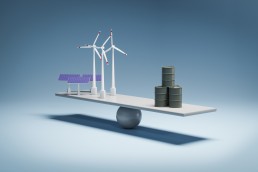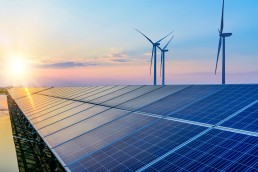What is agrivoltaics
Agrivoltaics refers to using the same land to generate solar electricity and support agriculture. As the world moves past the TW scale solar fleet and we deploy more solar every year, it is becoming increasingly difficult to find suitable land to develop solar projects. This situation is increasing concerns over the potential competition between using land to decarbonize the energy sector and sustainable agriculture, as lands most suited for a solar park often could be used to grow food. To address these concerns, the agriculture and solar sector collaborate to develop agrivoltaic projects that generate electricity while maintaining agricultural production.
Outline why agrivoltaic systems are becoming more popular
In addition to addressing land-use conflict concerns, agrivoltaics is a growing trend within the solar and agricultural sectors for several reasons. The agriculture sector is heavily impacted by climate change, due to increasing global average temperatures, unpredictable precipitation, and more frequent extreme weather events such as droughts and hailstorms. In this way, agrivoltaics not only mitigates climate change but also helps agriculture adapt by providing protection and shade to crops and animals.
Furthermore, agrivoltaics can enable sustainable development and increase investment in rural areas. Farmers can enjoy higher and more reliable agricultural yields, thanks to the better growing conditions that solar panels can provide. Rural communities can also benefit from locally sourced renewable electricity and obtain new revenue streams, in the form of land leases or the sale of electricity generation. Finally, solar can underpin the promotion of more sustainable agricultural practices, notably by replacing the use of single-use plastics and by providing more durable pest control measures that avoid the need for pesticides. Leasing out the farmland to a PV project could help the land recharge and recover.
The dual-use of land can provide additional income and work opportunities, as well as provide local communities with clean energy without sacrificing their livelihoods.

Advantages of solar PV for the agriculture sector
- Linking two sectors
Simply put, there’s only so much land that’s available. And with the increasing demand for clean energy, it’s important to consider the need for energy without neglecting the need for food. As an example, if we take two plots of land and dedicate them both to agrivoltaics, it could potentially yield twice the results than if the land use was divided. Additionally, this could become a diversified revenue stream for the parties involved, as the same land caters to two separate industries.
- Increased solar yield
Vegetation under the panels can be beneficial to energy production. The warmer the panels are, the less efficient they become. Plants can lower soil temperature by evaporating water, which in turn cools down the panels. Thus, the slight temperature regulation yields more energy production. Furthermore, plants can create complex variations in albedo which can affect bifacial modules. - Increased agricultural yield
Plants also benefit from the union between PV parks and agriculture. The panels provide shade for the vegetation, shielding them from direct sunlight and keeping them from losing too much water, which adds to the sustainability goals. According to SolarPower Europe, shading is especially useful in dry and water-limited areas, and can protect the vegetation against severe droughts. The use of panels could potentially extend the growing season as well.
Examples of agrivoltaic systems currently in use
- BayWa r.e. developed their first large scale 2.67 MW Agri-PV project in the Netherlands focusing on 3.3 hectares of raspberries. It’s one of the largest projects of its kind in Europe; with about 80% of electricity generation efficiency of a standard ground mount solar system and leading to increased crop yields when compared to standard raspberry plant protection systems. The project demonstrates how dual-use of land can contribute to climate protection and decarbonisation. BayWa r.e. stated their commitment to help farmers adapt to climate change, and hope their Agri-PV project will help promote the mix between solar energy and agriculture.
- Endesa launched 5 pilot projects, one of which is the Carmona solar plant project, which combines growing aromatic plants and keeping 50+ bee hives under solar panels. According to results, beekeeping improves crop productivity through increased pollination.
- Agrivoltaics installation at the Domaine de Nidolères in France hopes to revitalize the vineyard by covering 4.5 Ha with solar panels. Project was launched in 2018 and so far managed to achieve a 20% reduction in the plot’s water consumption, mitigate the damage of heatwaves, and improve acidity of the crops.
Adoption challenges
While agrivoltaics seem like a perfect solution, there are plenty of things to consider. Currently, agrivoltaics support only the shade-loving plants, which means that crops that require sunlight will not benefit from this practice. Also, the height of the vegetation needs to be accounted for. Larger plants will need panels to be raised higher as well, which impacts the structural integrity. In turn, panels will need to be built to account for wind and similar damage, and that adds extra costs. Currently, there’s a limited availability of technology suited for agrivoltaic projects. Countries also have different regulations regarding agrivoltaics, which can affect project permits and even potential financing and investments.
And in cases where the land is used for animal farming, it’s important to keep in mind the impact the animals will have on the panels. Additional care and maintenance will be required, which can become costly.
The future of agrivoltaics
Agrivoltaics hold the promise to simultaneously produce more clean energy while sustaining agriculture. Innovations in the use of tracking systems and transparent PV modules will bring additional opportunities to integrate more agricultural practices with PV systems.
The dual-use of the land could theoretically produce twice as many results – food and energy without sacrificing either – but there are roadblocks as well. Not all crops can be grown under the panels, and the temperature control that the panel provides is less efficient in the climates where there are no harsh climate fluctuations. That said, there’s no denying that dual-use of land would give stability to the increasing demand for solar; it would also provide farmers with an additional stream of revenue, since solar parks guarantee financial gain.
Agri-PV is getting more popular, as the world realizes the potential for generating electrical and agricultural yield from the same piece of land. PVcase Ground Mount has been adjusted to make it compatible with these new requirements.
You might also be interested in:
October 10, 2024
Net energy metering: how does it work and what are the benefits?
Learn about net metering, how it works and its benefits for renewable energy users and the grid.
October 9, 2024
Solar lease vs. buy: which is better?
Explore the benefits and drawbacks of leasing or owning solar panels to determine the best option for your renewable energy needs.
October 8, 2024
Solar energy vs. fossil fuels: what’s the difference?
Want to understand the differences between solar energy and fossil fuels? Explore the pros and cons, including their environmental impacts and financial considerations.
October 7, 2024
Is solar power truly renewable or nonrenewable?
Discover whether solar energy is considered renewable or nonrenewable and explore the benefits of solar power for a sustainable future.
October 6, 2024
Understanding on-grid solar systems. Powering homes and businesses
Find out how grid-tied solar systems work, their advantages and why they're popular for homeowners and businesses looking to harness solar energy efficiently.
October 4, 2024
Solar energy vs. wind energy. Pros and cons
Discover whether solar energy is considered renewable or nonrenewable and explore the benefits of solar power for a sustainable future.
October 3, 2024
Achieving household energy independence
Discover how energy independence through solar power can benefit your household, reduce costs, and contribute to a sustainable future.
October 2, 2024
Solar powered water heaters. A comprehensive guide to their value and efficiency
Many people in rural areas have difficulty accessing financial services, a problem exacerbated by energy insecurity. Solar power can help protect rural communities from energy…
October 1, 2024
Separating solar energy facts from fiction
Explore common solar energy myths and facts. Learn the truth about the efficiency, costs, and environmental impact of solar power in this guide.
September 30, 2024
Essential solar panel maintenance for peak performance
Learn key strategies for solar panel upkeep, from regular cleaning to performance monitoring. Maximize efficiency and extend system life.
September 27, 2024
Understanding smart power grid technology
Discover how smart grids modernize power systems, enhance efficiency and integrate renewable energy sources for a sustainable future.
September 26, 2024
Why do solar panels degrade?
How and why do solar panels degrade? Explore the factors contributing to their lifespan and what measures to take to extend it.
September 25, 2024
Solar panel and battery recycling
Learn effective techniques for recycling solar panels and batteries. Discover sustainable practices, legal requirements, and the environmental impact of proper disposal methods.
September 24, 2024
Will urban air transportation become widely available?
Learn about the latest innovations and practices that can further improve the sustainability of climate-resilient crops, benefiting both farmers and the environment.
September 23, 2024
Emerging innovations in unmanned systems
Unmanned systems can perform various tasks without the hands-on operation of a human, although they’re often operated remotely. These systems are increasingly being used in…
















